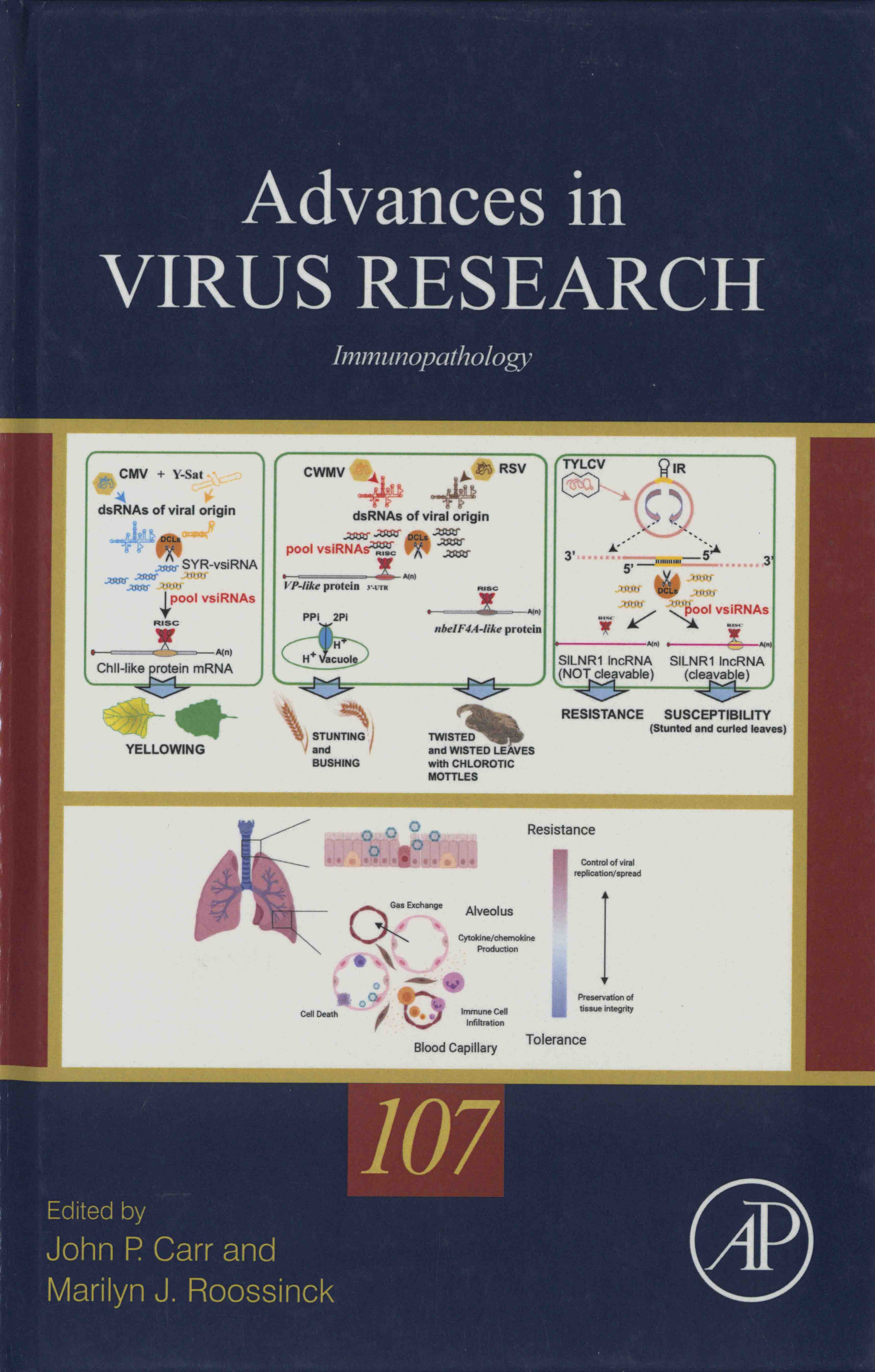 |
Immunopathology / edited by John P. Carr, Marilyn J. Roossinck. -- Cambridge, MA : Academic Press, 2020. – (58.679/A244/v.107) |
Contents
Contributors
Preface
1. Viral and subviral derived small RNAs as pathogenic determinants in plants and insects
1. Introduction
2. vsiRNAs containing sequence-specific phenotypic determinants
3. Revisiting the role of VSSs in infection and disease phenotype
4. Small RNAs-mediated diversion of the plant RNA silencing machinery
5, Small RNAs from viral and non-viral endogenous sequences
6. Concluding remarks
Acknowledgments
References
2. Hijacking of host cellular components as proviral factors by plant-infecting viruses
1. Introduction
2. Diversion of host defense components into viral protein complexes
3. Usurpation of cellular posttranslational dynamics during plant viral infections
4. Hijacking of host glycolytic enzymes for ATP production
5. Viral manipulation of intracellular ion homeostasis
6. Conclusions
Acknowledgments
References
3. Modulation of disease severity by plant positive-strand RNA viruses: The complex interplay of multifunctional viral proteins, subviral RNAs and virus-associated RNAs with plant signaling pathways and defense responses
1. Introduction
2. Evolutionary constraints driving disease severity
3. Regulating the impact of multifunctional viral proteins on plant intracellular structures and signaling pathways
4. Deploying subviral or virus-associated RNAs to manipulate symptom intensity
5. Selected examples of well-characterized plant-virus interactions
6. Concluding remarks
Acknowledgments
References
4. Host protein chaperones, RNA helicases and the ubiquitin network highlight the arms race for resources between tombusviruses and their hosts
1. Introduction
2. The heat shock protein 70 chaperone network
3. The pro-viral roles of co-opted protein chaperones in TBSV replication
4. The antiviral roles of co-opted protein co-chaperones in TBSV replication
5. Cellular RNA helicases and RNA chaperones
6. The pro-viral roles of co-opted DEAD-box helicases and RNA chaperone in TBSV replication
7. Comparison of protein chaperone and RNA helicase/chaperone functions
8. The ubiquitin network
9. The roles of the host ubiquitin network in TBSV replication and in the arms race with hosts
10. Summary
Acknowledgments
References
5. Update on immunopathology of bornavirus infections in humans and animals
1. Introduction and history
2. Classification, genome organization, viral life cycle arid virus-host interactions
3. Mammalian orthobornaviruses
4. Avian orthobornaviruses
5. Novel bornaviruses
6. Conclusions
Acknowledgments
References
6. Immunopathology of Zika virus infection
1. Zika virus: Discovery, outbreaks, and clinical manifestations of disease
2. Zika virus structure and life cycle
3. Zika virus immune antagonism
4. Animal models of Zika virus infection
5. African vs Asian Zika virus strains and pathogenesis
6. Development of neutralizing antibodies, diagnostic tests, and vaccines
7. Summary
References
7. One hundred years of (influenza) immunopathology
1. Vaccination, treatment, and health burden of influenza
2. The spectrum of influenza disease
3. Course of influenza virus infection in humans and mice
4. Course of disease in severe infections
5. Lung pathology in influenza
6. Role of the virus in tissue damage/pathology
7. Role of the host response in tissue damage
8. Future questions and potential therapeutic targets to reduce immunopathology
Acknowledgments
References
8. Immunopathology and immune homeostasis during viral infection in insects
1. Introduction
2. Antiviral immune pathways in insects
3. Immunopathology in insects
4. Restoring immune homeostasis
5. Concluding remarks and future directions
References
9. Immunopathogenesis of alphaviruses
1. Introduction to alphaviruses
2. Potential outcomes following alphavirus infection
3. Protective effects of the immune system during Alphavirus infection
4. Natural infection with alphaviruses
5. Alphavirus-induced arthralgia and myalgia
6, Alphavirus-induced encephalomyelitis
7. Conclusion and future directions
Acknowledgments
References
10. Reverse genetic systems: Rational design of coronavirus live attenuated vaccines with immune sequelae
1. Introduction
2. Coronavirus reverse genetics systems
3. Rational design of vaccine candidates using reverse genetics technology
4. Study the cell and tissue tropism of coronaviruses using reverse genetics
5. Screening antiviral drugs using reverse genetics
6. Conclusion and future directions
Acknowledgments
References